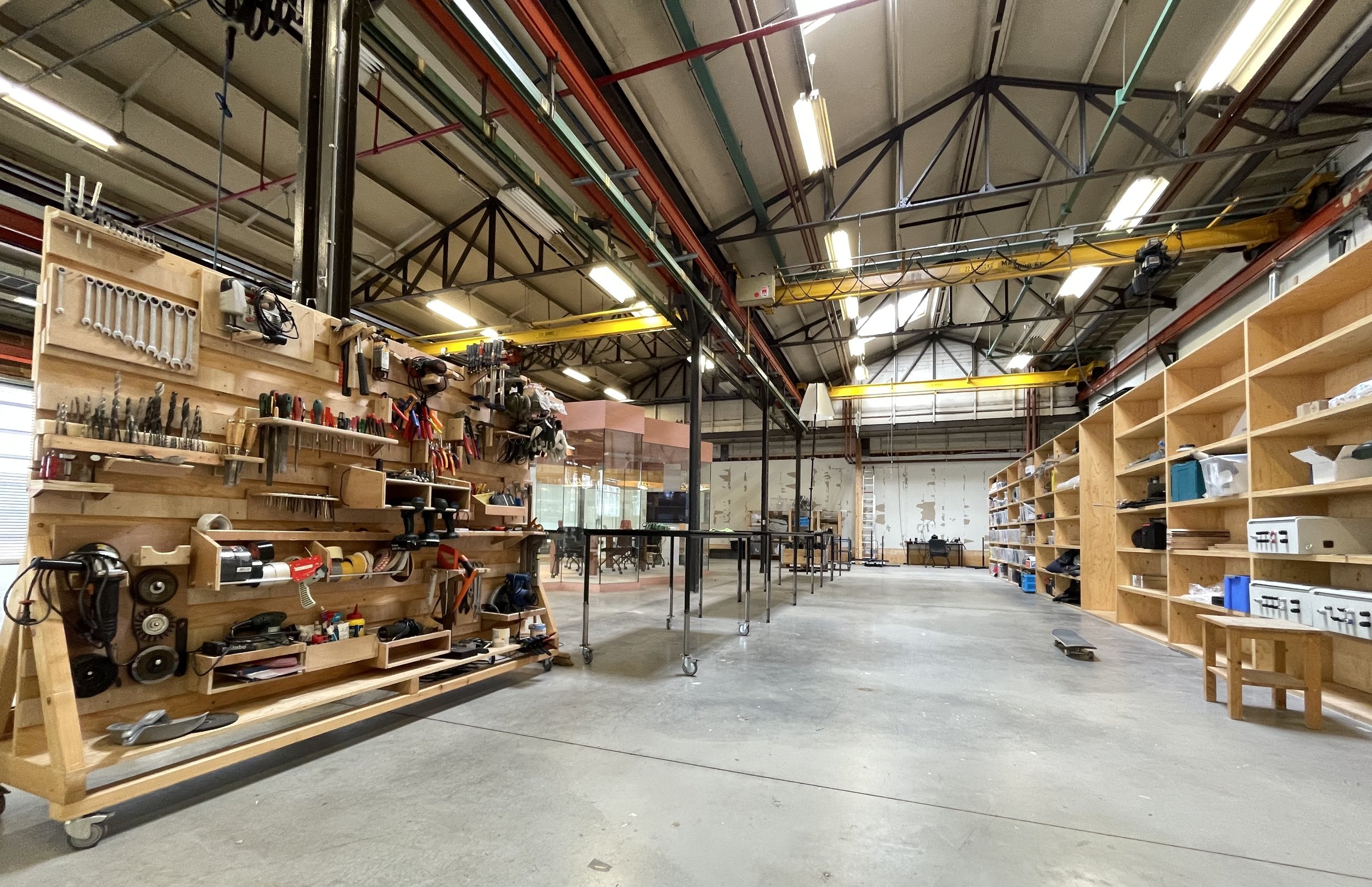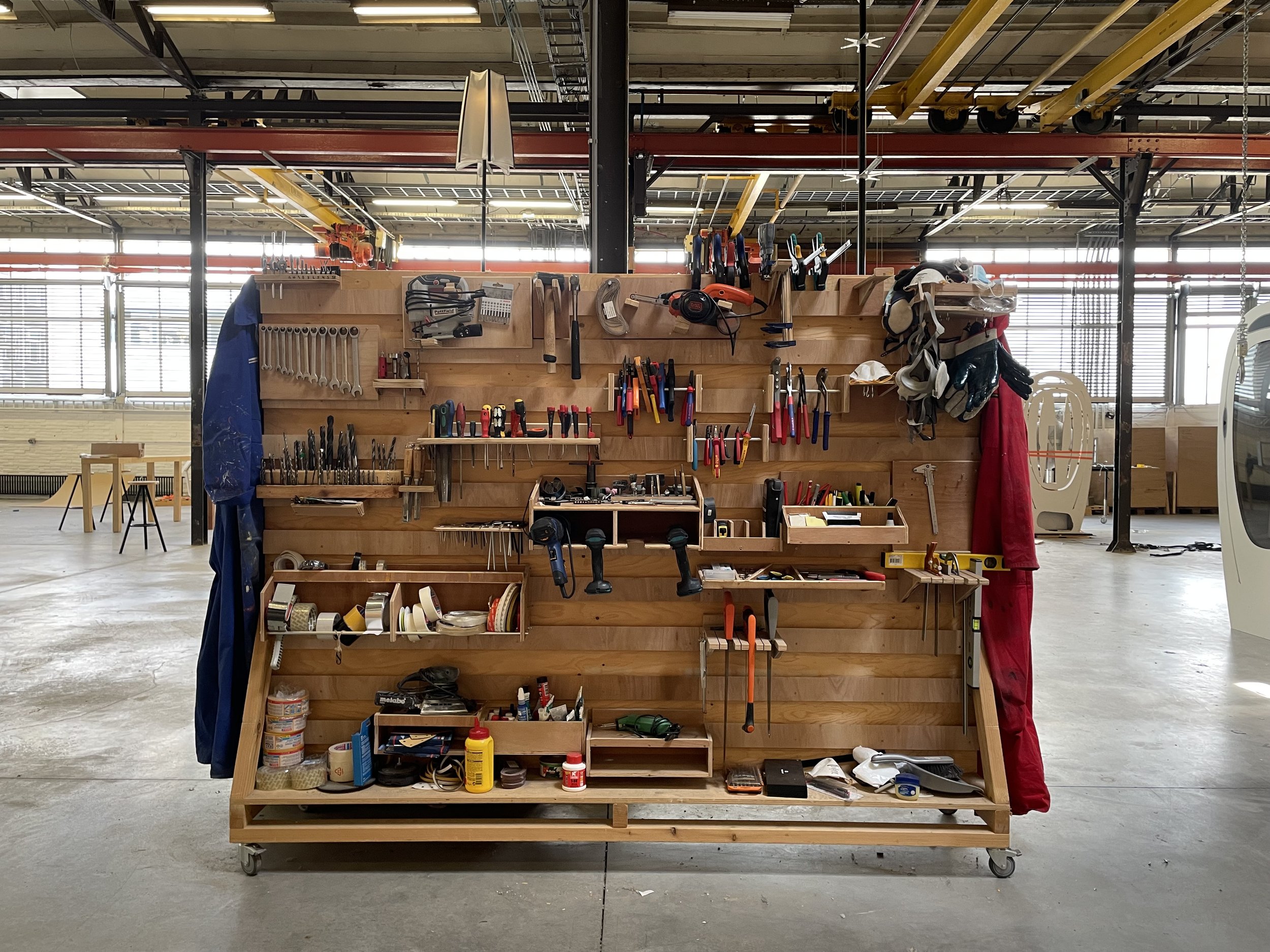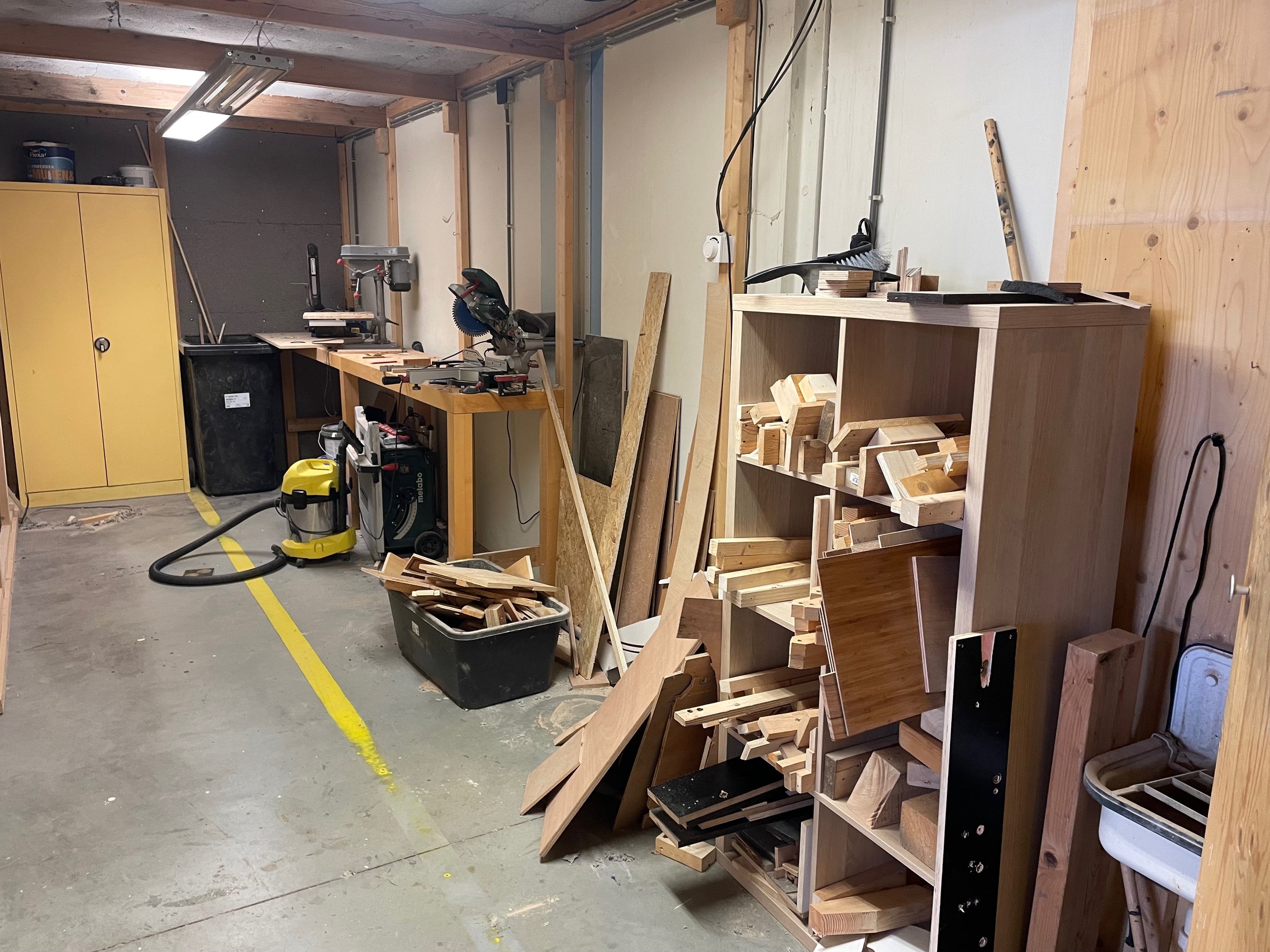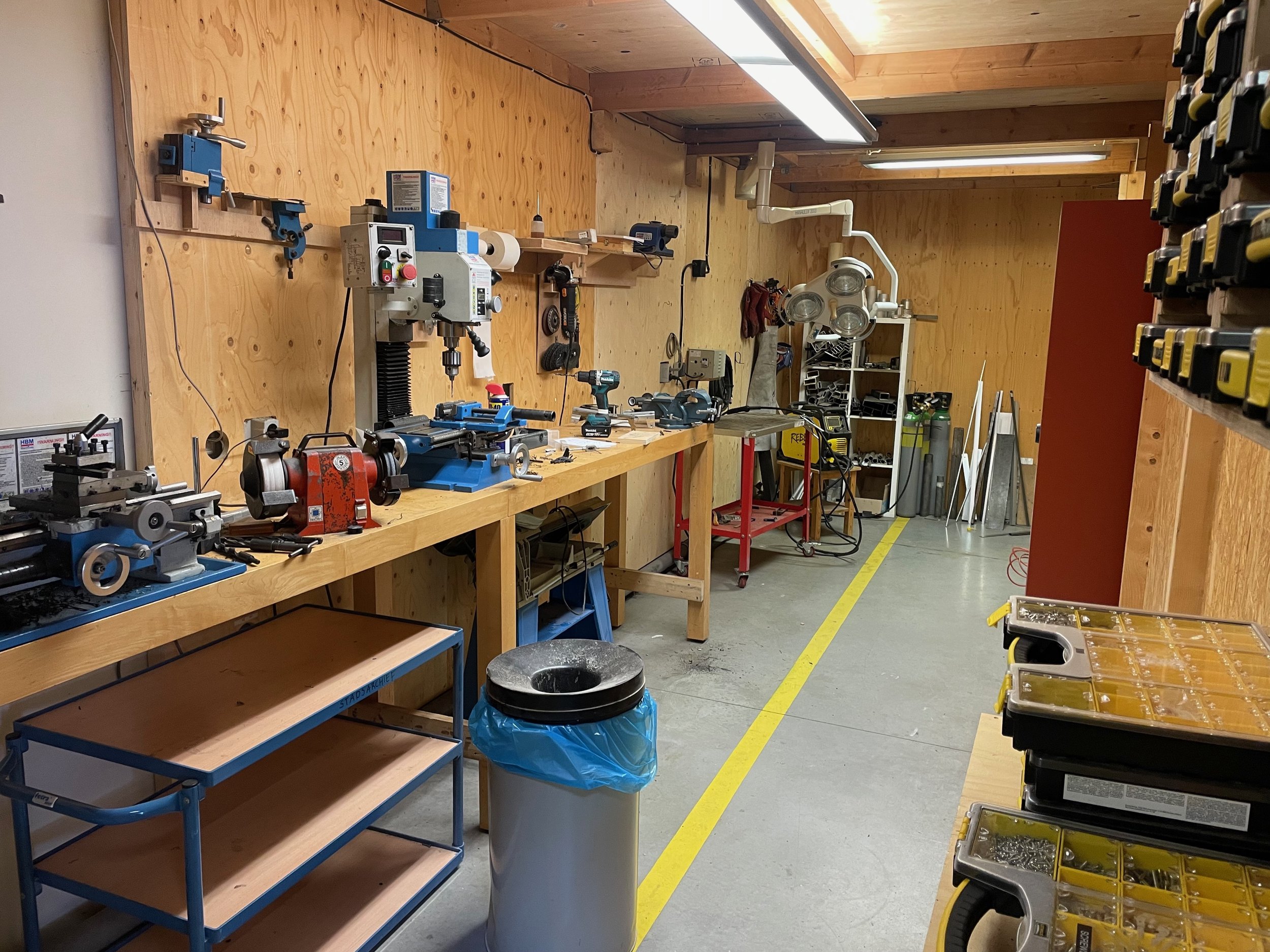Workshop
How to go about in our workshop
Safety first
Safety is paramount in the workshop. Always adhere to these guidelines to protect yourself and others:
Always wear safety glasses. If you’re not sure whether you need them, wear them.
Ensure the ventilation system is on whenever you’re working in the workshop.
Wear a mask when necessary, such as when cutting wood or painting.
Use gloves when appropriate, but never when operating cutting machines—they can get caught in the machinery.
Wear steel-toed covers over your shoes when handling heavy materials.
Make sure long hair is tied back, avoid loose clothing, and keep nails short to prevent accidents.
If you’re unsure about the safety or operation of a tool, always ask first or watch an instructional video until you’re confident you know how to use it safely.
Don’t work alone with machines you haven’t used before. Always have someone experienced nearby.
In the event of an accident, act responsibly. We have band-aids and first aid supplies located next to the entrance of the workshop.
In case of an accident
We prioritize everyone’s safety and well-being. If a work-related accident happens, you should report it right away to your supervisor. VOUW will take care of the situation. We are responsible for injuries caused by serious mistakes on our part; otherwise, our responsibility is limited to what our insurance covers.
Workshop etiquette
To maintain a productive and organized environment, follow these guidelines:
Every tool has a home: Put them back where they belong after use.
Clean up after you’ve finished working: It’s okay to leave projects out temporarily if appropriate, but the workshop is cleaned every one to two weeks by the whole team.
Restock immediately: When materials run out, either restock immediately or write it on the whiteboard. If you’re unsure, report it to Mingus or Simon.
Always have extra: When purchasing materials, buy 10% more than needed. Having just enough increases the risk of running out and losing time with additional trips.
Use only Torx: We exclusively use Torx screw heads. Avoid using Philips or flatheads unless absolutely necessary.
Use only locknuts: Always use locknuts, or if using regular nuts, apply Loctite to ensure they stay secure. Vibration can cause improperly torqued fasteners to loosen, which is a risk in installations.
Drilling is an art: Use the correct drill, speed, and pressure for each material. Metal drills are suitable for metal, wood, and plastics (drill plastics slowly and carefully). Wood drills should only be used for wood. Always use a center punch before drilling metal. Always check if the drill is sharp.
Measure twice, cut once: Always double-check measurements before cutting or drilling to avoid wasting materials.
Screw and Bolt Application: Use the exact screw bit that matches the screw or bolt. If not, you can damage the screw or the screw bit which will end in struggle.
Don’t use broken/bad tools: It will not get the job done. If you notice a tool is dull, damaged, or not working correctly, buy a new one, or report it immediately so it can be repaired or replaced.
Secure your work: Always secure your workpiece properly before cutting, drilling, or performing any task. Whether clamped or held securely by hand, a stable workpiece ensures accuracy and safety.
Use YouTube: A problem? A question? First go to YouTube before asking anyone else. Also check YouTube for things you think you know. YouTube will learn you how to actually do it.
Storage
We have designated storage areas and cabinets for all tools, materials, and household items. It’s essential to keep everything organized and return items to their designated spots after use.
French Cleat Tool Wall
Our small tools are stored using a French cleat system. Each tool has its place, making it easy to find what you need and ensuring everything is returned to its proper spot. Every tool should have a VOUW logo sticker for easy identification.
Large Wooden Cabinet
The large wooden cabinet along the side of the studio is divided into different vertical columns, each with its own purpose:
Current Projects: The columns closest to the workshop are dedicated to ongoing projects. Today, these include Bloomlight, Chairwave, and Poem Booth.
Other Areas: Other sections of the cabinet are organized into electronic and non-electronic areas, ensuring all related items are stored together and easily accessible.
Material Storage
Wood: Small wood pieces are stored in the wood workshop, while large wooden panels and pallets are kept in the storage area near the laser cutter. Long wooden beams are stored in the back corner of the studio.
Metal: Small metal pieces are stored in the metal workshop, and large metal tubes are kept in the back corner of the studio.
Plastic: Plastic panels, along with PVC and fiberglass tubes, are stored in the storage area near the laser cutter.
Household Items
Cleaning supplies, including brooms, can be found around the studio but are primarily stored near the sink area next to the toilet. This area also houses all other cleaning items.
Paints and Hazardous Materials
Paints, kits, and sanding paper are stored in the yellow cabinet in the wood workspace. Always ensure that these materials are handled safely and stored properly after use.
Organizational Systems
Each category of items is organized in its own labeled plastic storage container. All storage containers should be labeled clearly, and every tool should have a VOUW logo sticker for easy identification.
Recycling and Waste
Refer to the trash disposal guidelines for proper recycling and waste management. Make sure to follow these procedures to keep the studio clean and organized.
If you’re unsure where something belongs, ask a team member or refer to the labels and organizational systems in place. Keeping the workshop tidy helps everyone work more efficiently and safely.
Tools
Find below a list of the most important workshop tools and tutorials how to use them safely and without damaging the machine.
Cordless Drill: Makita DDF482RTJ
Impact Drill: Makita DTD153Z
Angle Grinder: Makita DGA506Z
Miter saw: Metabo KGS 216 M
Table saw: Metabo TS 254
Solder station: Weller WE1010 & TS101
Multimeter: UNI-T UT139A
Lathe: HBM 180 Vario Metaaldraaibank
Milling machine: HBM BF 25 Freesmachine
Metal band saw: HBM 115 Metaallintzaag
Welding machine: Esab Rebel EMP215-IC 230 volt
The wood workshop
The metal workshop
Instruction Videos





